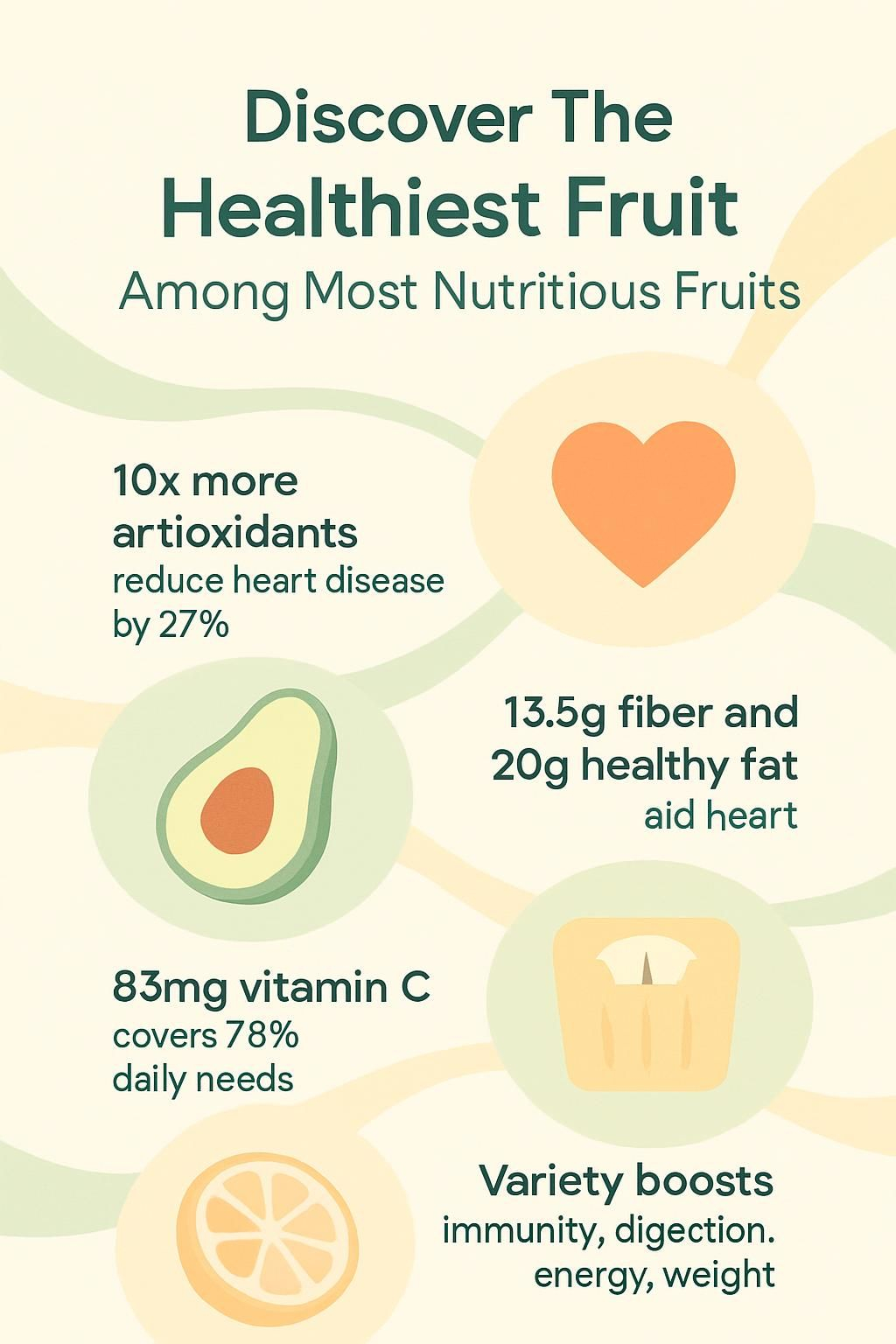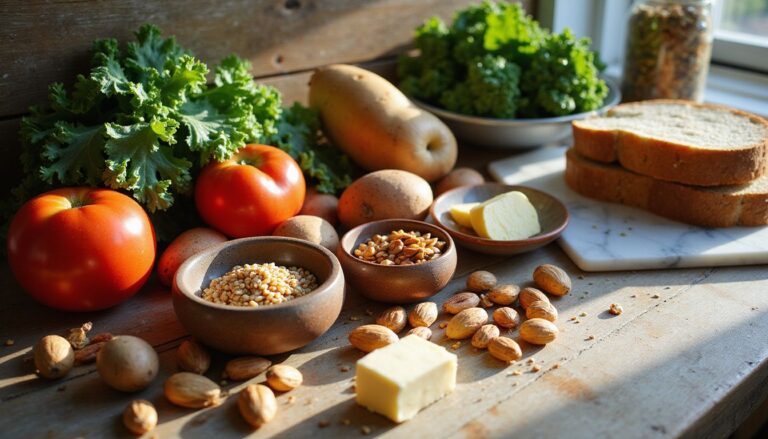Discover The Healthiest Fruit Among Most Nutritious Fruits
Our Nutrition Assistant AI Suite will transform your body. You will lose fat, get toned, and build muscle. Gain confidence and optimal health.
You want the healthiest fruit, yet the produce aisle is crowded with great choices. Each fruit brings its own mix of vitamin C, fiber, and antioxidant compounds that support health in different ways. Understanding those nutrients helps you pick nutritious fruits that match your goals.
In this guide, you will see why some fruits rise to the top. You will also learn the single best fruit to eat for antioxidants and how a mix of fruits may help reduce the risk of disease. Keep reading to find out which options deserve a regular spot in your plan.
This article is educational and not medical advice. If you have a health condition or take medications, talk with a healthcare professional about your diet.
Key Takeaways
- Blueberries rank first for antioxidant strength, with some studies linking higher intake to a 27% lower risk of heart disease (2021 review).
- Avocados provide about 13.5 g fiber and roughly 20 g monounsaturated fat per fruit, which supports heart health (Pacheco LS et al., 2022).
- One orange supplies about 83 mg vitamin C, close to 78% of your daily need, plus water and potassium for hydration and balance.
- A cup of strawberries gives more than 100% of daily vitamin C with only 48 calories, and supports cardio-metabolic health (Basu A et al., 2021).
- Eating a variety, including pomegranate, guava, kiwi, and bananas, supports immunity, digestion, energy, and weight control.

Why Are Fruits Important for Your Health?

Fruits and vegetables deliver essential nutrients that help your body work well. Large studies show that eating more healthy fruits may lower the risk of heart disease, certain cancers, and type 2 diabetes.
What vital nutrients do fruits provide?
Different fruits deliver different nutrients. Citrus fruit like oranges, lemons, and pomelos are rich in vitamin C. One medium orange has about 82.7 mg of vitamin C. A half cup of blueberries supplies about 7.28 mg.
Apples give you about 4.37 g of fiber and 8.4 mg vitamin C per medium fruit, plus potassium for heart health. Minerals such as calcium, iron, and potassium show up in bananas, apples, avocados, and mangoes.
Avocado stands out for its monounsaturated fat, often called healthy fat, and close to 1,000 mg potassium per fruit. That amount supports blood pressure and helps maintain energy. Mango provides about 67% of daily vitamin C in one cup and adds polyphenols, plant chemicals that may lower inflammation.
I often start mornings with an apple or warm lemon water. It helps me hit my fiber and vitamin C goals early and keeps my digestion on track.
Vitamin A and vitamin K appear in many fruits. Guava is high in fiber and vitamin A. Pomegranate offers polyphenols that support blood vessels and the immune system.
How do antioxidants and fiber benefit your body?
Antioxidants defend your cells from oxidative stress, which is cell damage from normal metabolism and pollution. Berries, including blueberries, blackberries, and raspberries, are rich sources. A 2021 review of 59 studies linked higher berry intake with up to 27% lower heart disease incidence.
Blueberries may slow plaque buildup in arteries, which supports healthy blood flow. Fiber is another key nutrient. Pears, guava, avocados, and bananas provide fiber that supports regularity and feeds helpful gut bacteria.
One cup of raspberries contains about 9.75 g of fiber, near 35% of your daily value. Blackberries add anthocyanins, the plant pigments that act as antioxidants, and nearly 4 g of fiber per serving. Fiber also helps steady blood sugar so your energy stays even.
How do fruits support overall health and prevent diseases?
Daily fruit intake supports heart health and reduces the risk of long-term diseases. Diets rich in apples, blueberries, pomegranate, and grapefruit link with lower rates of heart disease, diabetes, obesity, stroke, and certain cancers.
About one third cup of blueberries per day has been linked with lower risk for type 2 diabetes and heart problems. Anthocyanin-rich berries are also tied to a nine percent drop in deaths from heart disease.
Pomegranates supply polyphenols that support blood sugar control and help cholesterol. Mango supports gut health in ways fiber supplements do not. Eating 100 to 150 grams of apples per day can help reduce cholesterol and blood pressure.
Fruits add vitamin C from oranges, potassium from bananas, and B vitamins such as folate from kiwi and peaches to support red blood cells. A mix of fruits strengthens immunity, aids digestion with pectin, a type of fiber, improves blood lipids with flavonoids in cherries and strawberries, and keeps calories in check.
Key Factors That Define a Healthy Fruit
Fruits vary in nutrient density, which affects their health benefits. Look for options high in fiber, rich in vitamin C, and packed with antioxidants to support the health of your body.
What is nutritional density in fruits?
Nutrient density means how many useful nutrients you get for the calories you eat. Avocado is a nutrient-dense fruit because it delivers vitamin C, fiber, potassium, and healthy fats in a modest serving.
One avocado offers about 20 mg vitamin C and 13.5 g fiber in a 201 g portion. Oranges are an excellent source too. A single fruit provides over 80 mg vitamin C for around 65 calories.
Fruits that deliver vitamins A and C, minerals like potassium and magnesium, and fiber, but stay reasonable in calories and sugars, give you greater nutritional value. Swapping an afternoon snack for a kiwi gave me more steady energy due to its vitamin C and natural carbs.
High nutrient density means each bite supports your health without adding empty calories.
How does antioxidant content affect fruit health benefits?
Fruits high in antioxidants, such as blueberries, strawberries, raspberries, blackberries, and pomegranates, support heart health and may lower the risk of chronic disease. Their anthocyanins and other polyphenols protect cells from free radicals, the unstable molecules that can damage tissues.
Berries can deliver up to ten times more antioxidant activity than many fruits or vegetables. A handful of fresh blueberries in the morning often helps me stay focused through long study sessions.
Grape polyphenols, like resveratrol, may activate sirtuins, proteins tied to healthy aging and brain protection (Zhou DD, 2021). Pomegranate polyphenols help calm inflammation. Peach peels can have up to 27 times more antioxidant activity than the flesh (Manzoor M et al., 2012). Eating edible peels raises your intake of these helpful plant chemicals.
Which vitamins and minerals are important in fruits?
Vitamin C stands out in oranges, lemons, strawberries, kiwi, mangoes, and pineapple. It protects cells and helps your immune system. Potassium appears in bananas, avocados, apples, and pomegranate. It supports heart function and fluid balance.
Vitamin A is found in mangoes, apricots, peaches, and cantaloupe, supporting vision and skin. Vitamin K shows up in pomegranate, Asian pears, and grapes. It helps blood clot normally. Folate comes from lemons, avocados, oranges, and Asian pears and supports cell growth.
Grapes, lychee, pomelo, and Asian pears provide copper for red blood cell formation. I began adding fresh orange juice to my breakfast during flu season, and I noticed fewer colds and better energy.
Eating a variety helps you cover these nutrients while enjoying natural sweetness from fruits and vegetables every day.
How do fiber and hydration levels contribute to health?
High fiber fruits keep digestion moving. Raspberries have 9.75 g per cup, about 35% of daily needs. Apples offer 4.37 g per fruit with the skin. Avocados deliver 13.5 g per serving.
Pears provide around 6 g each, and a medium banana gives over 3 g. Fiber supports heart and gut health and may lower the risk of diabetes. Hydrating fruits also help your body work well.
Oranges and strawberries are top choices because they combine high water content with vitamin C and potassium. Pineapple adds hydration plus more than 2 g of fiber per large slice. Swapping chips for a juicy orange or a crisp apple helped me meet water goals and kept my energy steadier at work.
The Healthiest Fruits Ranked by Benefits
Experts rank the healthiest fruits by total nutrients and health effects. Compare the options and build a plan that fits your taste and goals.
Why are blueberries considered antioxidant powerhouses?
Blueberries are one of the healthiest fruits you can eat for antioxidants. A 75 g serving, about half a cup, has only 42.8 calories with 1.8 g fiber and 7.28 mg vitamin C.
They are rich in anthocyanins and pterostilbene, plant compounds that reduce inflammation and protect cells. Eating about one third cup per day has been linked to lower risk for type 2 diabetes and heart disease.
A 2021 review showed high anthocyanin intake was tied to a 27% lower chance of heart disease and a nine percent drop in heart-related deaths. Blueberries can have up to ten times more antioxidant activity than many fruits and cruciferous vegetables. They are easy to add to yogurt, oatmeal, or salads.
What makes avocado rich in healthy fats and fiber?
Avocado is a standout for heart health and fullness. A 201 g serving contains about 13.5 g fiber, which supports digestion and satiety. You also get about 20 g of monounsaturated fats, the type that can help lower LDL cholesterol and reduce stroke risk.
Avocados deliver potassium, about 975 mg, plus magnesium, vitamin A, beta carotene, folate, and even a little protein. Research from Pacheco LS et al., 2022 links regular avocado intake with lower cardiovascular risk.
I began adding sliced avocado to my lunch salads. My energy stayed steadier through the afternoon compared to days without it. Including avocado along with berries like strawberries and cherries helps balance a lower carbohydrate approach with key minerals and healthy fat.
How does pomegranate provide polyphenols and vitamin K?
Pomegranate is rich in polyphenols, which act as antioxidants and help control inflammation. A 282 g serving provides 52.7 g carbs and 11.3 g fiber, along with a strong antioxidant profile.
Reviews from 2020 link pomegranate intake to lower risk of obesity, diabetes, heart disease, and certain cancers. Pomegranate also contains vitamin K for normal blood clotting and bone health. One large fruit gives about 46.2 micrograms of vitamin K. Adding the seeds to salads or yogurt is a simple way to raise your antioxidant intake.
Why are oranges a great source of vitamin C and hydration?
Oranges are a reliable source of vitamin C. One medium fruit, about 140 g, provides around 82.7 mg. That is close to 78% of your daily value in a single serving.
Vitamin C supports immune defenses and skin health. Oranges also contain B vitamins such as thiamin and folate. Thanks to high water content and potassium, about 232 mg, oranges support hydration and fluid balance.
Each orange gives roughly 2.8 g fiber with about 65 calories. They travel well, which makes it easy to boost vitamin C on busy days.
How do strawberries offer antioxidants with low calories?
Strawberries deliver many antioxidants with very few calories. A 150 g serving has only 48 calories and more than 100% of daily vitamin C.
Each cup gives about 3 g fiber and 11.5 g carbohydrates. Their red color comes from anthocyanins that support heart health. You also get thiamin, riboflavin, niacin, folate, vitamins B6, A, and K, plus calcium, magnesium, and potassium.
Research by Basu A et al., 2021 ties regular strawberry intake to lower LDL cholesterol and stronger antioxidant defenses. They make an easy snack or smoothie add-in when you want flavor without many calories.
What fiber and vitamin C benefits do apples have?
Apples are an easy way to add fiber. A medium apple, about 182 g, supplies 4.37 g of fiber, especially if you eat the peel. This supports healthy digestion and helps lower cholesterol levels.
Studies from 2020 suggest that 100 to 150 g of apples per day may reduce blood pressure and cholesterol. Apples also provide about 8.37 mg vitamin C to support immune and skin health.
I often grab an apple as a portable snack. It keeps me satisfied for under 100 calories and fits any meal plan focused on whole foods.
How does grapefruit boost immunity and aid weight management?
Grapefruit helps you hit your vitamin C goal. One cup meets almost 100% of daily needs. Vitamin C supports immune cells as they fight everyday pathogens.
Grapefruit is low in calories and contains about 2.46 g fiber per half fruit. That fiber helps you feel full with fewer calories. High water content adds hydration and helps with appetite control.
Grapefruit provides potassium, calcium, magnesium, and flavonoids such as naringin, which protect cells from damage (Stabrauskiene J et al., 2022). Pink or red grapefruit also contains special compounds that may support cell protection. Many people include grapefruit in weight loss plans because it is satisfying and nutrient dense.
Why are bananas high in potassium and energy-boosting carbs?
Bananas are well known for potassium. One medium banana, about 126 g, provides around 451 mg. Potassium helps manage blood pressure and can prevent muscle cramps after workouts.
Bananas also supply quick energy from about 28.8 g of carbohydrates per fruit. The 3.28 g of fiber supports digestion and keeps you full longer. Bananas are affordable and easy to carry, so they fit into any routine.
How does kiwi support digestion with vitamin C?
Kiwi supports digestion and immunity. One medium kiwi offers about 71 mg vitamin C, nearly a full day’s need. Vitamin C protects tissues as an antioxidant and supports immune function.
Kiwi contains fiber that promotes regular bowel movements and feeds helpful gut bacteria. It also has actinidin, a natural enzyme that helps break down protein, which may ease post-meal discomfort.
Water content in kiwi keeps you hydrated and helps food move through the digestive tract. Sliced kiwi on oatmeal helped ease my mild constipation and made breakfast more refreshing.
This small fruit is nutrient dense with few calories, yet it delivers meaningful benefits for digestion and immune health.
*USDA FoodData Central, 2020
What fiber and vitamin A benefits does guava provide?
Guava is high in fiber, which supports regularity and helps prevent constipation. The fiber absorbs water and adds bulk to stool. It may also help lower blood sugar by slowing absorption.
Guava provides vitamin A for vision and immune support. It also aids cell growth and skin health. You get these benefits with few calories, which makes guava a smart choice.
Guava contains potassium to support heart health and antioxidants that protect cells. If you eat a wide variety of fruits, including guava, you cover many nutrients with ease.
Fruits That Are High in Antioxidants
Some fruits are antioxidant standouts. Think of them as your daily shield against cell damage from stress and pollution.
Which berries have the highest antioxidant levels?
Blackberries and blueberries sit near the top. A 75 g portion of blackberries has only about 32.2 calories with almost 4 g fiber, 21.8 mg calcium, and 15.8 mg vitamin C. Blueberries in a similar serving provide about 42.8 calories with close to 11 g carbohydrates and useful potassium.
Raspberries shine for fiber, near 10 g per cup, plus vitamin C, vitamin K, manganese, and strong antioxidants like anthocyanins. A 2021 review linked berry intake with a 27% lower incidence of heart disease, likely due to reduced inflammation and cell damage over time.
Fresh strawberries also deserve a spot. A cup gives close to 90 mg vitamin C with around 48 calories, which makes them one of the best fruits for a low calorie antioxidant boost.
How does pomegranate contribute antioxidants?
Pomegranate delivers a potent mix of antioxidants, especially polyphenols. A 282 g serving contains 234 calories, 52.7 g carbohydrates, and 11.3 g fiber.
You also get about 28.8 mg vitamin C and 46.2 micrograms vitamin K. These nutrients help neutralize harmful free radicals. A 2020 review links pomegranate intake to lower risk of obesity, diabetes, heart disease, and certain cancers.
Pomegranate antioxidants support healthy blood pressure and circulation. I enjoy adding the seeds to yogurt after training. It helps me feel recovered and keeps my snack nutrient dense.
What antioxidant benefits come from grapes?
Grapes provide polyphenols such as flavonoids, phenolic acids, and resveratrol. These compounds can lower inflammation and support healthy aging through sirtuins, proteins that help protect cells.
Grapes also deliver copper, vitamin K, and B vitamins for cell health. Research suggests grape polyphenols are linked to lower heart disease risk. Antioxidants in grapes may also help protect the brain. Fresh grapes or raisins make it easy to get these benefits every day.
Fiber-Rich Fruits That Aid Digestion
Fiber supports a balanced gut, regular movements, and a healthy microbiome, which is the community of helpful bacteria in your digestive tract.
How do pears support digestive health with fiber?
Pears deliver a strong fiber boost. One Asian pear provides about 6 g per serving. Fiber in pears promotes regularity and keeps stool soft because it pulls in water.
Eat pears with the skin on to maximize fiber. Pears also bring potassium, vitamin C, vitamin K, copper, folate, and magnesium. Their low calorie count supports fullness and weight management while feeding the helpful cells in your gut lining.
Why is avocado considered fiber-rich?
Avocado is fiber-rich. A 201 g avocado contains about 13.5 g dietary fiber, which is more than half the daily goal for many adults.
This fiber supports regular movements, steadier blood sugar, and lower cholesterol. Avocado also provides monounsaturated fat, which helps with nutrient absorption. Add slices to salads, sandwiches, or smoothies to raise fiber quickly.
Each serving also delivers magnesium, potassium, calcium, vitamin C, and small amounts of protein and carbs. For another simple fiber add-on, bananas are a practical option.
How do bananas improve digestion through fiber?
Bananas support digestion with about 3.28 g of fiber per 126 g fruit. This mix of soluble and insoluble fiber helps restore normal bowel function and keeps you regular.
Bananas are gentle on the stomach and easy to digest, so they are useful during mild digestive upset. I often add banana slices to oatmeal or blend them into smoothies to bump up fiber at breakfast.
Fruits That Are Excellent Sources of Vitamin C
Vitamin C supports your immune system and helps your skin make collagen, which keeps tissues strong.
How much vitamin C do oranges provide?
One medium orange, about 140 g, provides 82.7 mg vitamin C. That covers roughly 78% of your daily value in a single serving.
Oranges also add 232 mg potassium, about 2.8 g fiber, and only around 65 calories. The high water content aids hydration. B vitamins like thiamin and folate support metabolism and normal cell growth.
I like to add an orange to breakfast or eat one as a mid-morning snack. It is an easy way to keep vitamin C intake high.
What vitamin C benefits come from strawberries?
Strawberries earn a top spot for vitamin C. A 150 g serving gives 88.2 mg, which is more than your daily need.
Vitamin C strengthens the immune system and helps your body build collagen for skin and wound healing. With only 48 calories per 150 g, strawberries offer a light way to get antioxidants, fiber, and potassium, about 230 mg per cup.
I like to add sliced strawberries to yogurt after workouts. The taste is fresh, and I feel ready for the afternoon without a heavy snack.
How does kiwi contribute to vitamin C intake?
Kiwi is a vitamin C leader. One medium kiwi can meet or exceed daily needs. The antioxidants protect cells, while the fiber supports gut health.
Vitamin C in kiwi also boosts iron absorption from plant foods, which is helpful if you follow a vegetarian or vegan diet. I enjoy adding kiwi to salads. The tangy flavor gives leafy greens a lift while raising vitamin C.
Kiwi is low in calories, so you can add extra servings without much impact on total intake.
Why include pineapple for vitamin C?
Pineapple provides about 88% of daily vitamin C in one cup. That supports immune function and skin health. Pineapple also supplies bromelain, a natural enzyme that helps with inflammation.
One large slice has only about 83 calories and 21.7 g carbohydrates. I often mix fresh pineapple chunks into yogurt at breakfast during cold season. It pairs well with strawberries or lemon for more flavor and nutrients.
How Can You Add More Fruits to Your Diet?
Small changes make a big difference. Add fruit to meals you already enjoy and keep easy choices on hand.
What are easy ways to add fruits to smoothies?
Blend fresh berries like blueberries, strawberries, or raspberries for antioxidants. Add sliced bananas for energy and natural sweetness.
Use frozen fruit for a thicker texture and steady nutrient levels without added sugar. Include oranges or kiwis for vitamin C and hydration.
Blend whole apples or pears with the skin to boost fiber. For variety, toss in spinach or kale, which stay mild next to fruit. Try lychee or kumquat for a new twist. Smoothies make it easier to reach the four to five daily servings recommended by nutrition groups.
How can fruits be used as healthy snacks?
Fruits are portable, quick, and satisfying. A banana or apple travels well and needs no prep. Pair fruit with nuts or cheese for protein, which keeps you full longer.
One medium fruit or half a cup of sliced fruit counts as a serving. Change up your picks to cover more nutrients that support heart health. Research links steady fruit intake with lower risks of heart disease and diabetes.
I carry small containers of strawberries and grapes for busy afternoons. That habit helps me skip packaged snacks that add sugar without nutrients.
How to include fruits in salads and desserts?
Add strawberries and blackberries to salads for color and antioxidants. Mix in citrus like oranges or lemon for brightness and more vitamin C. Avocado brings healthy fats and a creamy texture.
Use sliced fruit to sweeten desserts instead of extra sugar. Blend berries or bananas into smoothies or top yogurt parfaits with mixed fruit. Puree mango or kiwi into dressings for a fresh, tangy kick. Rotate your fruits through the week to increase variety and nutritional value.
Understanding Organic vs. Non-Organic Fruits
Organic choices can reduce exposure to synthetic pesticides. Labels and local sources help you choose what fits your health goals and budget.
What are the benefits of choosing organic fruits?
Organic fruits grow without synthetic pesticides or fertilizers. That means lower chemical residues and healthier soil over time. Some studies suggest higher antioxidant and mineral levels in organic produce compared with conventional options.
Buying organic can support biodiversity and sustainable farming. Many people also notice fresher flavor, especially from local markets. Fewer additives during growing and handling may support better digestive comfort for some people.
When should you prioritize organic fruit options?
Consider organic options for children and during pregnancy to limit exposure to pesticide residues. Some organic fruits may contain more antioxidants and helpful plant compounds.
If you care about sustainable farming or biodiversity, choosing organic supports those goals. Local and seasonal organic fruits often offer better freshness and taste. Certified labels can provide assurance when you select staples for your kitchen.
Tips for Selecting the Best Fruits
Smart shopping helps you get top quality, better flavor, and the most nutrients per bite.
Why choose seasonal fruits?
Seasonal fruits are picked closer to peak ripeness. That often means more vitamins, minerals, and antioxidants, plus better taste and texture. Buying local seasonal produce can lower cost and reduce the carbon footprint from transport.
Eating a range of seasonal choices improves nutrient coverage. Studies link a varied, fruit-rich pattern with lower risk of heart disease and diabetes. Rotate your picks with the seasons for value and freshness.
How to select ripe and fresh fruits?
Pick fruits with bright color and a firm feel. Skip items with bruises or soft spots. Avocados should yield slightly to gentle pressure without feeling mushy.
Choose berries that are plump and richly colored. At the market last summer, I learned that peaches with a firm, fragrant feel turned out juicier at home.
Store fruit in a cool place away from sunlight or in the refrigerator. This step helps preserve nutrients like vitamin C in oranges and strawberries. Keep variety in your basket to cover more nutrients across the week.
Why buy a variety of fruits for balanced nutrition?
Variety helps you get a wide set of vitamins, minerals, fiber, and antioxidants. Blueberries supply antioxidants. Oranges offer vitamin C. Strawberries and guava add different plant compounds.
Health groups suggest four to five servings daily. Fresh or frozen unsweetened options are best. Canned or dried versions can be helpful in a pinch, but they sometimes include added sugars.
A colorful mix supports heart health, digestion, immune function, skin, and weight management. Once you know what is in season, building a balanced cart gets easier.
Conclusion
The healthiest fruit depends on your needs and taste. Blueberries lead for antioxidant activity. Avocados bring healthy fats and fiber. Oranges deliver vitamin C and hydration. Together, these nutritious fruits support heart health, digestion, immunity, and steady energy.
For best results, eat a mix across the week. Choose ripe, fresh fruit, and enjoy it in snacks, salads, and smoothies. If you have medical concerns or take prescriptions, especially for blood pressure or blood thinners, ask your clinician how to fit these fruits into your plan.
FAQs
1. Which fruit is considered the healthiest among the most nutritious fruits?
Blueberries often rank as one of the healthiest fruits due to their high antioxidant content, low calories, and rich supply of vitamins C and K. A 2020 study in Advances in Nutrition found that regular blueberry consumption supports heart health and cognitive function.
2. What nutrients make a fruit highly nutritious?
Fruits like oranges, kiwifruit, and pomegranates are packed with fiber, vitamin C, potassium, folate, and antioxidants such as flavonoids or polyphenols. For example, a medium orange provides about 70 mg of vitamin C which meets daily needs for most adults according to USDA data.
3. How can I include more healthy fruits in my diet?
Adding sliced strawberries or mangoes to breakfast cereal or yogurt increases nutrient intake without much effort. In my own experience preparing mixed fruit salads each week helped me eat more variety while keeping meals interesting.
4. Are there risks linked with eating large amounts of even the healthiest fruits?
Eating too many sweet fruits like grapes or bananas may raise blood sugar levels especially for people managing diabetes according to research published by Harvard Health Publishing. Moderation ensures you get benefits from nutrients without excess sugar intake.
Summary: Blueberries stand out for their nutritional value but other options like oranges and kiwifruit also offer key health benefits supported by scientific studies. Including a range of these foods helps meet daily nutrition goals while keeping your diet balanced and enjoyable.







